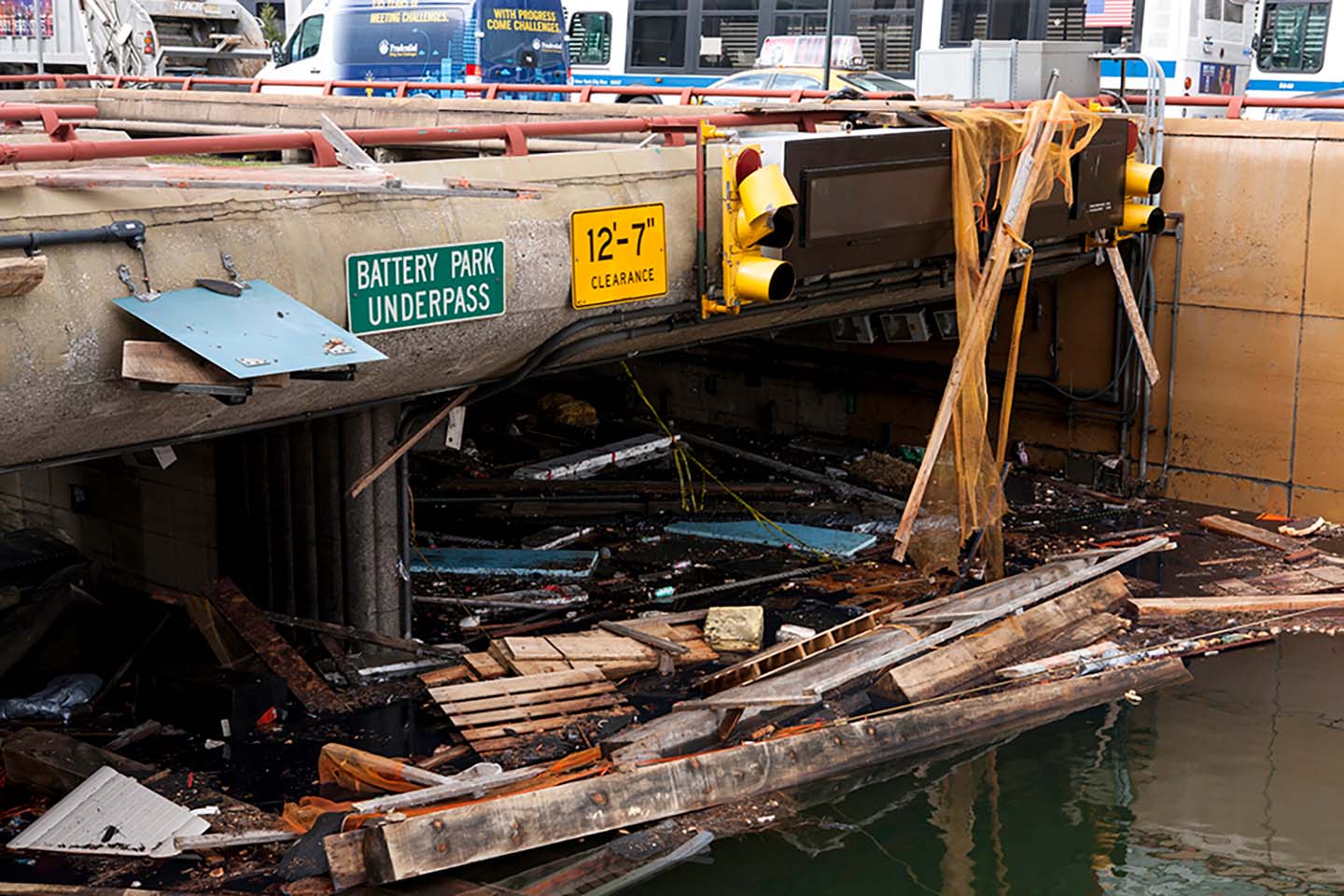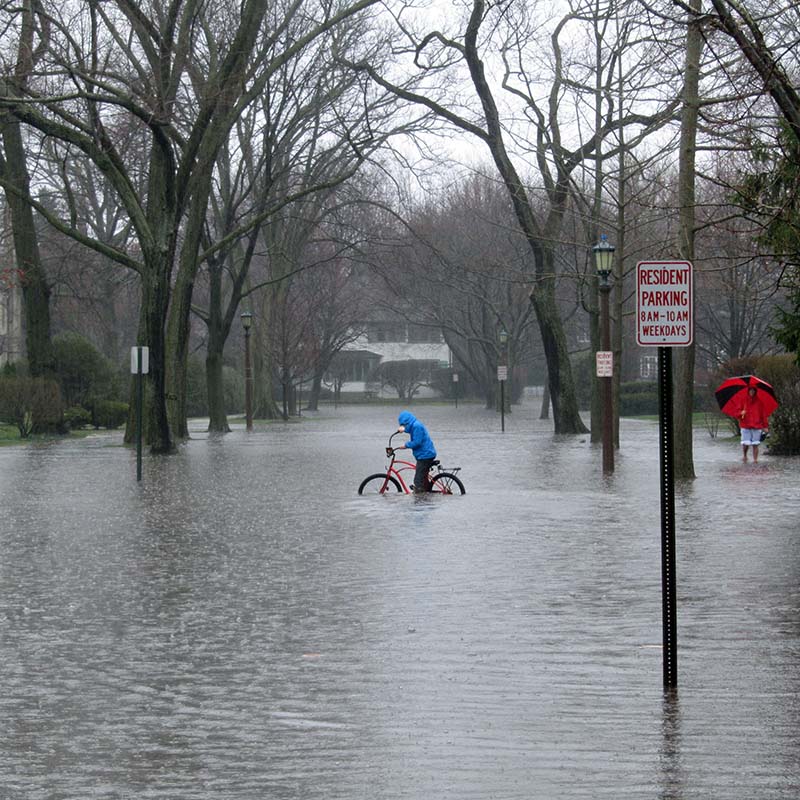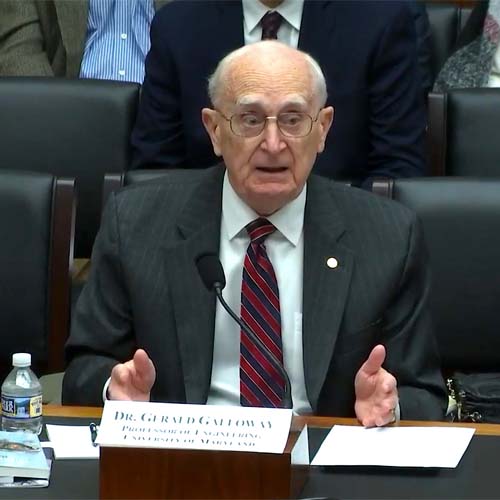The Great Wet Threat
Three experts break down the planet’s most costly hazard—and where we go from here.
Three experts break down the planet’s most costly hazard—and where we go from here.
Flooding is a global crisis with cataclysmic consequences: It displaces people, bleeds economies, and erodes both the natural and built environment. Unrelenting storms are becoming more pronounced with climate change, and the risks of aging infrastructure are made more pervasive by a reactive system and political inertia.
For decades, three senior engineers at Maryland—Gregory Baecher, Gerald Galloway, and Ed Link—have had front row seats to the power and devastation of water. All three have decorated careers with the Army Corps of Engineers and have consulted for government agencies around the world. They have written a library of books and reports sounding the alarm; Galloway, jokes Baecher, has testified on Capitol Hill with the frequency of running to the grocery store.
In 2004, shortly after converging their successful careers at Maryland, the three started meeting regularly as part of the Water Resources Collaborative; within two years, the group completed a FEMA-backed study on the effectiveness and utility of the 100-year flood criterion. In 2005, Maryland was ground zero for the forensic analysis of Hurricane Katrina, with Link at the helm of the Interagency Performance Evaluation Taskforce. For the past decade, their work has examined infrastructure and the insurance industry, failed systems, and—most notably—the country’s lack of preparation for what is on the horizon. “In the United States government, there is no secretary of disasters,” Galloway points out.
Baecher, Galloway, and Link discuss with Engineering at Maryland magazine a nation on the brink of inundation, how we got there … and how we might get out.
It seems only recently that climate change has been a more universally accepted smoking gun. Was there a storm that served as a particular wake-up call?
Link: I think we’ve had a number of wake-up calls. We didn’t initially look at Katrina as a climate-driven event: It was the highest coastal surge that North America had ever experienced, but it certainly wasn’t the most intense hurricane. All of the water gauges were wiped out, so there were no measured data; we had to model it, recreating the storm coming into the gulf and hitting New Orleans. We then modeled another 152 hypothetical storms so that we could get a climatology and put Katrina into perspective. That’s when we realized just how unique it actually was.
But the more revealing thing was just how unprepared we were as a nation to deal with things that shouldn’t be a surprise.
Baecher: Katrina was terrible and caused a lot of problems, but the history of floods in America goes back to colonial times. There’s a long history of cataclysm when it comes to storms and coastal flooding.
What are we not doing that we should be doing right now to address flooding in the United States?
Baecher: We aren’t preparing.
Link: One-hundred percent. If you look at the big picture, 90 percent of the money spent in the disaster arena is spent on recovery from events that have occurred; only 10 percent is spent on mitigating future risk. We have a terrible inverse relationship with where the money should go. I mean, the best way to get a big check sent to your community is to have a disaster, right? But don't ask for money to prevent a disaster from occurring, because you won't get a very big check.
Civil and environmental engineering professor Bilal Ayyub and Center for Technology and Systems Management associate director Dan Walker will facilitate a partnership to accelerate the development of climate-smart engineering practices.
The partnership calls for a series of exchanges between NOAA and American Society of Civil Engineers (ASCE) to advance the use of NOAA-produced climate science in the design and construction of climate-resilient infrastructure by developing and updating ASCE codes and standards.
Read More
The Battery Park Underpass in Manhattan flooded with seawater during Superstorm Sandy. Photo courtesy of the NYC Department of Transportation.
What does preparation look like and who is doing it right? Are there any countries we should be learning from?
Link: First is understanding where and why you’re vulnerable. Second is developing a strategy for reducing that vulnerability.
The best example I’ve seen is from the Dutch. They created the Delta Program to refresh their look at flood risk—since 60 percent of their country is below sea level, they take it very seriously. I was a part of an advisory committee that completed a major systems scenario modeling analysis of the country. We looked at different possible futures and calculated the sensitivity of the infrastructure within the country to deal with those different scenarios. Then we conducted a risk assessment to develop what I can best call an incremental adaptive strategy. There’s so much uncertainty with climate change; we can’t estimate what it’s actually going to be like in 50 years. So, they developed a contingency plan: For instance, when they see one meter of water increase, they will do the following things, and they had a plan to do that. If they see two meters, then they will do something else. There was a Plan B to augment Plan A. And then there was a plan C to augment Plan A and B, so as they go into the future and actual changes unfold, they have a plan in place for how to deal with it systematically.
What’s an example in this country of a short-sighted project to combat flooding?
Link: New Orleans. Read volume one of the Performance Evaluation of the New Orleans and Southeast Louisiana Hurricane Protection System; it lays out what went wrong from an engineering performance perspective. Another report, Decision-Making Chronology for the Lake Pontchartrain & Vicinity Hurricane Protection Project, looked at the decisions that led up to the system that was in place when Katrina hit. It’s a real mystery novel. The sin was that Congress incrementally funded that project to build protection around New Orleans for 40 years. That project began in the 60s but never received enough money in order to finish.
Galloway: That’s the tip of the iceberg. We know that the way we build projects is not very useful for getting them done quickly.
Baecher: Also, the way we fund water projects is different from the way we fund most other infrastructure. Much of water infrastructure is appropriated every two years by Congress through something called the Water Resource Development Act, but all of that money is project-specific. In contrast, the Department of Transportation gets a big lump of money, and the Secretary gets to decide how to use it. It’s a totally different funding approach. For water infrastructure, it’s very inefficient and just reeks of control and micromanagement.
Is water our biggest threat to civilization as far as natural disasters are concerned?
Baecher: Well, the answer is, only indirectly. Climate change is clearly an existential threat. Flooding is the most expensive natural disaster worldwide, no question about that. It costs money and lives.
Link: I really don’t want to say this, but I hope that as climate impacts become more serious, it really does get to the point where people have to respond, and they have to realize that they can’t just respond individually or locally. We’ve got to respond nationally and internationally to fix this. It’s the same as a pandemic: We can’t solve the COVID problem in the U.S. if we don’t confront it globally. You just can’t solve a problem like this locally or in only one portion of the world.
Baecher: I think Gerry and Ed would agree that while North America has some flood problems, if you look at the big deltas around the world—the Brahmaputra, the Nile, the Mekong—those are hosts to hundreds of millions of residents, most of whom are poor and all of whom sit within a few meters of sea level. And flooding of those deltas will be disasters, or already are. It’s going to generate refugee loads that are unprecedented.
As communities convert more land into roads, buildings, and other impervious surfaces, drainage systems—themselves often aging, undersized, and difficult to maintain—reach capacity faster, leaving flood waters to devastate homes and businesses.
A report by UMD's Center for Disaster Resilience and Texas A&M University (TAMU), the first to assess the national scope and consequences of urban flooding, found that communities across the country are struggling to address the growing extent of the threat. Lawmakers at all levels of government must define responsibilities, the report says, and take strategic steps to support locally led mitigation efforts.
Read More
Photo by Village of Kenilworth, Illinois
What can we do?
Link: We have to create a value proposition for doing this thing differently.
Baecher: There are some economic impediments to rational planning. One of the big issues is multimillion-dollar homes along the Carolina and Georgia coast: It’s not a matter of if, it’s a matter of when they get wiped out. But in the meantime, developers build a house and sell it to someone who has no idea what they are buying. The developer has made a pile of money and gotten rid of the risk. The local jurisdiction earns real estate taxes, so there’s no incentive for them not to issue the permits. And then the federal government comes in after the disaster and shovels out money to help everybody. And many of those people are not insured or couldn’t get flood insurance because the risks were so high. The economic incentives are perverse.
Are people resigning themselves to the fact that these places just won’t be around in the near future?
Baecher: Coincidentally, I was listening to an interview with the mayor and the public works director of Miami. One of the senior public works guys from Miami was saying “look, we’re not going to be able to protect it forever. But if we can extend the life for another 50 years so and people can get benefit for another 50 years, that might be worth all the investments we’re making.”
But the fact is that we’re going to have to retreat from places like Cambridge, Maryland and Virginia Beach and parts of Cape Cod. And that’s just the way it is—but no one wants to hear about retreat.
Link: A big leap in recent thought was when a majority of people began to realize they could not prevent Louisiana from losing coastline—and it’s losing coastline very, very rapidly. They just decided that instead of trying to mitigate where we are now, we’ve got to think about mitigating where we’re going be in 20 years. That was a huge change in perspective. Projecting and dealing with preserving a shoreline or a coastline that is practical relative to nature’s forces, that makes a lot of sense.
Gerry, you were recently on Capitol Hill talking about natural systems and what they could do for flood mitigation. Are there specific interventions we should be investing in to help protect communities?
Galloway: Natural systems are gaining traction in urban places, and they’re wonderful for the community. I’m a big advocate of what’s been done in China: They’ve committed to capturing 70 percent of the water inside their eight largest cities within eight years. I’ve been in four of those cities and taken dance classes in the middle of these wetland parks. The public sure likes them and in the middle of a concrete city, they do make a difference. Nature-based systems or low-impact development is very, very important. But it’s only one tool. And here’s the truth: Natural systems aren't going to save cities when you have a huge downpour.
Where should our students be concentrating their efforts?
Link: As they say in hockey, you skate to where the puck is going to be, not where it is.
Baecher: Several of us [faculty in the Department of Civil and Environmental Engineering] wrote a paper for the National Academy of Engineering’s The Bridge magazine on how to train the next generation of civil and environmental engineers for resilience. It’s something that as a discipline we are pushing.
Galloway: There are a lot of young people who are carrying on the ideas and lessons learned from the studies we’ve done, running the Floodplain Management program, serving in the Corps of Engineers, involved in water resources, or are running things internationally. And we’ve got bright young faculty and students who care and are enthusiastic about this, too.
In one of his numerous testimonies before Congress, Gerald Galloway called on lawmakers to remove barriers to interagency co-operation and authorize the U.S. Army Corps of Engineers (USACE) to use updated Principles, Requirements, and Guidelines.
"We’re told the same thing by state agencies: we would like to help, but we can’t," Galloway said.
Galloway spoke against restrictions barring the Corps from utilizing an updated set of Principles, Requirements, and Guidelines that include environmental and social factors among the criteria for authorizing a project. As a result, Galloway explained, low-income populations and agriculture-heavy areas of the country do not receive adequate flood protection, since efforts are channeled into areas deemed to be of higher economic value.
Read More
Gerald Galloway testifying before the House Transportation Subcommittee on Water, Resources, and Environment on November 19, 2019